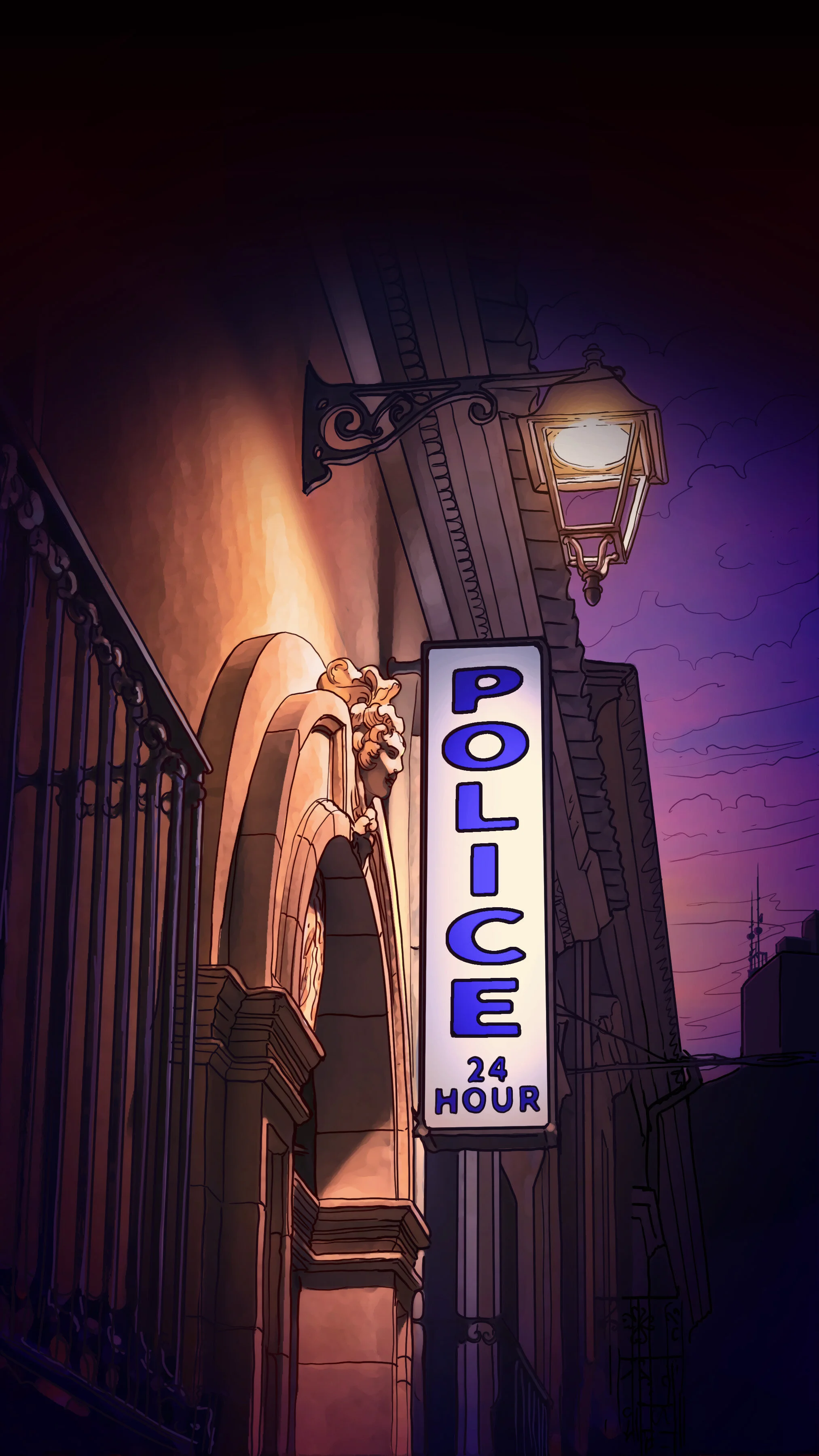Illustration Notes for Episode Thirty-Nine
According to last week’s illustration notes, you are reading this as my wife and I help prepare for her stepfather’s memorial service in Ukiah, California, and assist in other tasks around the resolution of his estate— after a three-day drive down the coast from Orcas Island. But that turns out to be inaccurate. The memorial service and all other California errands have been indefinitely postponed—for reasons that are surely too obvious to need explaining here—so I am, and will remain, right here at home, cranking out new episodes of TWICE for you to read while you’re stuck in self-quarantine, desperate for distraction. …No, no, thank me later. ;]
All that said, I’ve stuck with the red and blue color scheme of my ‘police procedural’ episodes here—as you can see—and have decided on a more visually interesting police station than the brick, cement, aluminum, and plate glass structures so commonly seen these days. This decision about what kind of police station to draw is actually a significant one, reflecting an important aspect of my intent throughout this story. …Allow me to explain.
You may have noticed—(Hmmm… Should I really point this out to you? So soon? Or ever? …Oh, what the heck.)—that I have never actually named this city—or the county it’s in, or the state. Nor will I, ever. I’ve done this for the same sort of reason that I’m now trying to depict major characters up close as infrequently as possible. One TWICE reader recently expressed curiosity about “exactly where in California” this city was. She’d been trying to figure it out from “hints” in my comments about the weather and the time of nightfall… When I asked her what made her think it was in California at all, she replied, “You said it was—in the story.”
But I hadn’t. There are references to southern California—where something important did/will happen. But I assured her that I never had, and never would provide clues to where this city—or state—is, exactly, because I want people to do just what she did: make it the city they think it should be. I want it to be a city where anything could happen. The instant I identified this city, whole categories of options would instantly become impossible. The only city that can really contain this story is the city in your mind.
But that doesn’t mean I want to write a bland or generic city. Not at all. By the time this tale is halfway done—much less all through—I hope this city will have become such a vivid, interesting, entirely ‘real’ place that you’ll continue thinking about and wanting to visit it—if only in your mind—long after the tale is finished. I believe my chances of achieving that are better if I offer lots of vivid glimpses, but am careful to let YOU fill in as many of the blanks between them as possible. YOUR fabulous, distinctive, vividly varied, and sometimes creepy or mysterious city will be MUCH richer than mine—to you. …Which brings me back to this police station.
It doesn’t actually exist anywhere in America. But it could! In order to provide you a city that is simultaneously nowhere identifiable, yet vivid and ‘real,’ I need to know the full, detailed story of each building or location I depict. I need to know its age and history, its location in the city and the history and character of that district or neighborhood. Believe it or not, I work at this—whether any character in the story ever mentions, much less explains, any of that back-knowledge to you or not. So let me tell you a few things about this police station:
It isn’t in the current downtown area. It’s just over a mile east of that, well back from the river, in what locals call ‘the old town,’ which was the city’s center until just under a hundred years ago—when the city’s business hub started creeping west—toward higher ground along the river front. (This is not a new city. But it’s not so old that it couldn’t be found in pretty much any of the lower forty-eight states—’cause, yes, all right—it’s pretty clearly not in Hawaii or Alaska.) This police station didn’t start as one. The building was originally an indoor market—as old as ‘old town’ itself—that was re-purposed and converted—about forty years ago—into a police station as the city’s population—and crime rate—began increasing more rapidly. This old building had been re-purposed and altered before, of course, many times across the years. But converting it into a police station was complicated by the fact that the building was a designated historical landmark by then. Thus, the facade had to be preserved—right down to the ornate sculpture above its main entrance. The inside is much more remodeled—and looks like what you’d expect of a modern police station. Nonetheless, behind and underneath its newly reinforced and sheet-rocked walls, the building’s historical bones remain—along with many of the original structure’s ‘attachments’—on more than one level—to another, very different city, long ago…and its underground.
Will all or any of that information turn out to be important to the story? …I really couldn’t say—right now. But the information is there; that’s what matters. And as this city blooms and grows in my mind, sometimes it tells me parts of this story that even I hadn’t known about. I am still discovering this city too, and my own ‘illustrations’ often tell me as much about my story as they tell you.
Below, as always, find an uncropped and uncluttered version of the illustration to consider. :]
